|
Khalid Shaikh MohammedHe's been compared to James Bond and Forrest Gump, but Khalid Shaikh Mohammed is more accurately compared to Leatherface from the Texas Chainsaw Massacre, with just a dash of Tony Manero from Saturday Night Fever (except uglier).After all, Forrest Gump never killed 3,000 people in one day.
Sept. 11 was simply the pinnacle of a decade-long streak of spectacular mass murders, distinguished primarily by their ability to end the lives of completely innocent bystanders who had no idea why anyone would want to kill them. The origins of al Qaeda's arch-terrorist are shrouded in mystery. We're pretty sure he was born either in Kuwait or in Pakistan. We're pretty sure he was Ramzi Yousef's uncle. He was born sometime around 1965. We can speculate that he must have had the mother of all fucked-up childhoods, but we have no conclusive data on this point. He was a college-boy, and an American college boy to boot. He attended Chowan College in North Carolina, where he was known for chiding his fellow Muslims for their apostate ways. He lunched with pals at Burger King and cultivated hatred for the decadent American empire, perhaps inspired by beer-sotted bullying at a frat party.
After meeting with Ramzi Yousef and Hakim Abdul Murad in Pakistan in 1994, the three merrily set off for Manila, the Philippines, in the fall of 1994, on a junket funded by Osama bin Laden and Asian terror kingpin Hambali. There the real work of glamorous international terrorism began. But all work and no play makes Khalid a dull mullah. Not unlike a pedophile priest, Khalid fervently believed the strict tenets of Islam should be unwaveringly observed by everyone but him. On the surface, Khalid's time in the Philippines was more distinguished for its flashy playboy lifestyle than for the notches added to his belt. Khalid and Yousef went on scuba diving expeditions and frequented local discotechques "filled with mirrors, flashing lights and bikini-clad dancers," according to the LA Times. They held alcohol-soaked parties and made notably non-devout booty calls to infidels with pouty breasts all over Manila. He once buzzed an office building in a helicopter in an attempt to impress a local woman. If one were both mean-spirited and salacious, one might speculate as to the implications that such inordinate and over-the-top courtship techniques might have vis a vis penis-size-related insecurities. (Not to mention the Freudian implications of obsessively seeking to crash big airplanes into even bigger towers.)
Khalid rented an apartment for the conspirators, and they set to work. Yousef was the explosives expert, and he began designing new and better bombs. Chief among them was a "microbomb" for use on airplanes. The device used a Casio digital watch and a contact lens solution bottle filled with nitroglycerin. It made for a virtually undetectable bomb which could be set on a timer. While Yousef mixed explosives, Khalid was working on a plan to use them. The plan was called Operation "Bojinka," which the intelligence community has determined means "Big Bang" in some damn language. It's not clear how they translated the word without being able to identify the language, but that's why they're the intelligence community and we're just a bunch of fucking slobs on the Internet. Bojinka was scheduled to go off on Jan. 21, 1995, according to "The Cell," a book on al Qaeda by John Miller, Michael Stone and Chris Miller, a time frame that is generally confirmed by most media reports. Had it been successful, most estimates place the prospective death toll at about 4,000. The plan called for the roughly simultaneous detonation of bombs on eleven U.S.-bound airliners over the Pacific. Yousef would design the timed bombs, which would be planted by just five operatives. The operatives would board a U.S.-bound flight with a layover somewhere in Asia, plant the bomb on board and then disembark before it detonated. Then they would rinse, lather and repeat on another plane. But there was a second phase to Bojinka, one which will be painfully familiar to most readers. In phase two, Abdul Murad (a U.S.-trained pilot) would fly a hijacked airplane into CIA headquarters or the Pentagon. The idea was apparently all Khalid's. When being questioned (with extreme prejudice) by Philippines authorities later, Murad indicated that Khalid had extremely interested in finding pilots when they first met in Pakistan the previous year.
But the next explosion was deferred. In early January, the apartment caught fire after one of the cell's lesser lights made a mistake mixing chemicals. The fire was quickly extinguished, but it attracted the attention of the local gendarmes. Murad was caught when Yousef sent him back into the apartment to retrieve the cabal's documents and computers. The police were stunned when they uncovered a plot to assassinate the pope during a trip to Manila and another to assassinate then-President Bill Clinton. They applied their arts of gentle persuasion (i.e., Torture) to extract as many details as possible before extraditing Murad to the U.S., where he was eventually sentenced to life in prison. U.S authorities now had a complete blueprint for Sept. 11 in their hands, confessions extracted under torture from one of the conspirators, and evidence of the involvement of Ramzi Yousef then the most-wanted terrorist in the world and the only Islamic terrorist ever to successfully execute an attack on American soil. You would think that all these factors would create a real state of alarm. Not exactly. Clinton designated a state of National Emergency to deal with terrorism, and the whole incident pretty much slipped out of view. The intelligence community added Khalid Shaikh Mohammed to a couple of target lists, and went on its merry way. No one realized how important he was, or how important he would become. Khalid escaped the Philippines and traveled the world, eventually ending up in Afghanistan and Pakistan, where he worked as a top deputy to Osama bin Laden.
His presence extended so far that he gained a reputation in intelligence circles as the "Forrest Gump" of terrorism, because he seemed to be lurking in the background of almost every major act of terror in the last five to ten years. Intelligence circles might have been better off trying to catch Khalid than crafting clever metaphors to describe him, but there are only so many hours in the day. Investigators may have forgotten about Bojinka, but Khalid never did. As he rose through al Qaeda's ranks to the leadership of the terrorist group's "military committee," he kept working to make his pet project a reality. Funneling money and training to operatives around the globe, particularly in Hamburg, Germany, Khalid relentlessly moved forward to make the Sept. 11 plan a reality. In an interview with an Arabic news network, he admitted to his central role in making the attack happen, both with funding and logistical support. After the devastating attack on the World Trade Center, Khalid took on a much higher profile in the war on terrorism, although few outside media and professional law enforcement circles knew his name. The U.S. offered a $25 million reward for his capture and stepped up efforts to track him down, amid a vicious storm of second-guessing and intramural backstabbing among intelligence agencies desperate to avoid taking blame for not noticing this guy sooner. Despite the international manhunt, Khalid continued to travel and to instigate attacks on the U.S. According to the international press, Khalid's Pakistan-based al Qaeda cell sent "dirty bomber" Jose Padilla to the United States in 2002 (where he was promptly captured). Khalid was also directly tied to a major bombing of nightclubs in Bali and a truck-bomb attack on the U.S. embassy in Karachi, both of which were executed using fertilizer bombs of the same type used in the Oklahoma City bombing. In March 2003, the Pakistani government arrested Khalid in a safehouse outside of Islamabad. According to the Pakistanis, they accomplished this monumental feat "all by themselves," without any assistance at all from the small army of U.S. secret agents in the country to handle various "advisory" tasks. Government sources instantly fanned out over Washington to anonymously inform reporters that such archaic institutions as the "courts" and the "criminal justice system" are not likely to ever be applied to Mohammed Shaikh Khalid, the one man on Earth who is most clearly responsible for the Sept. 11 attack. President George W. Bush characterized the arrest as "fantastic" evidence of the success of his crusade to bring the perpetrators of 9/11 to "justice." In that spirit, he immediately authorized the removal of Khalid to parts unknown in the custody of persons unknown to be subjected to forms of interrogation unknown for a duration unknown. Now that's justice! Isn't it? |
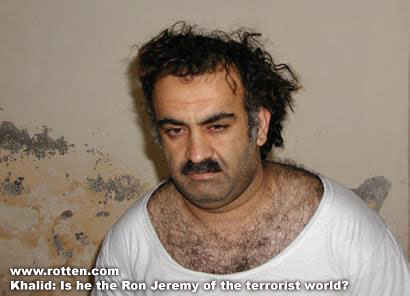 The No. 3 man in
The No. 3 man in 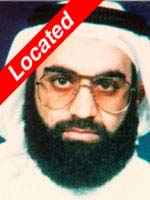 Whatever the source of his maniacal hate, Khalid first emerged on the terrorism scene in the early 1990s. He may have played a role in the first attempt to destroy the WTC in 1993, according to investigators, who said he wired money to the primary bomber, his nephew, Ramzi Yousef.
Whatever the source of his maniacal hate, Khalid first emerged on the terrorism scene in the early 1990s. He may have played a role in the first attempt to destroy the WTC in 1993, according to investigators, who said he wired money to the primary bomber, his nephew, Ramzi Yousef.
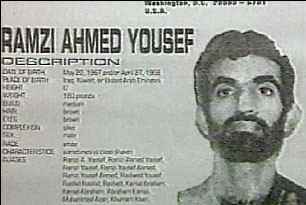 But the trip to Manila was about a lot more than scoring some easy local tail. With Yousef and co-conspirators Abdul Hakim Murad and Wali Khan Amin Shah, Khalid spent his time dreaming big dreams of mayhem. By most accounts, the four had been sent to the Philippines by bin Laden himself, charged with devising spectacular attacks on America. They did not disappoint.
But the trip to Manila was about a lot more than scoring some easy local tail. With Yousef and co-conspirators Abdul Hakim Murad and Wali Khan Amin Shah, Khalid spent his time dreaming big dreams of mayhem. By most accounts, the four had been sent to the Philippines by bin Laden himself, charged with devising spectacular attacks on America. They did not disappoint.
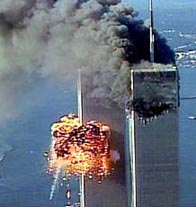 In December 1994, Yousef tested his bomb in a movie theater and on an airplane bound for Tokyo. The bomb didn't destroy the airplane, although it did kill a passenger. Yousef adjusted the formula so that the next explosion would do the job.
In December 1994, Yousef tested his bomb in a movie theater and on an airplane bound for Tokyo. The bomb didn't destroy the airplane, although it did kill a passenger. Yousef adjusted the formula so that the next explosion would do the job.
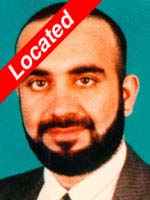 Khalid kept himself busy with embassy bombings in Africa, the attack on the U.S.S. Cole and other terrorist attacks. He sent orders, instruction and money to the operatives who would carry the attacks out. He traveled the world under as many as 20 falsified passports, narrowly escaping U.S. authorities on several occasions.
Khalid kept himself busy with embassy bombings in Africa, the attack on the U.S.S. Cole and other terrorist attacks. He sent orders, instruction and money to the operatives who would carry the attacks out. He traveled the world under as many as 20 falsified passports, narrowly escaping U.S. authorities on several occasions.